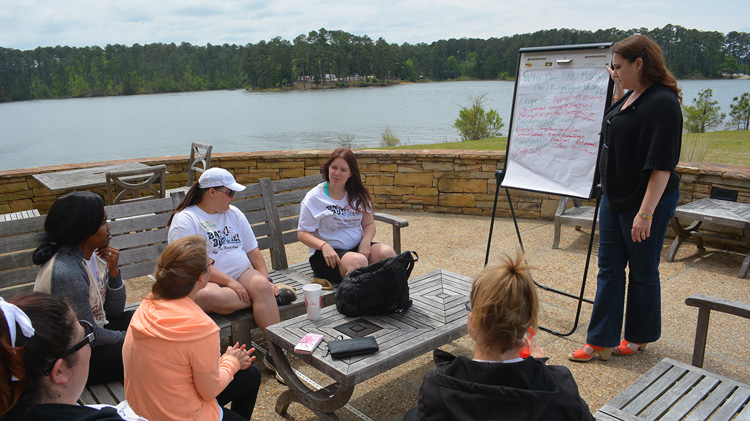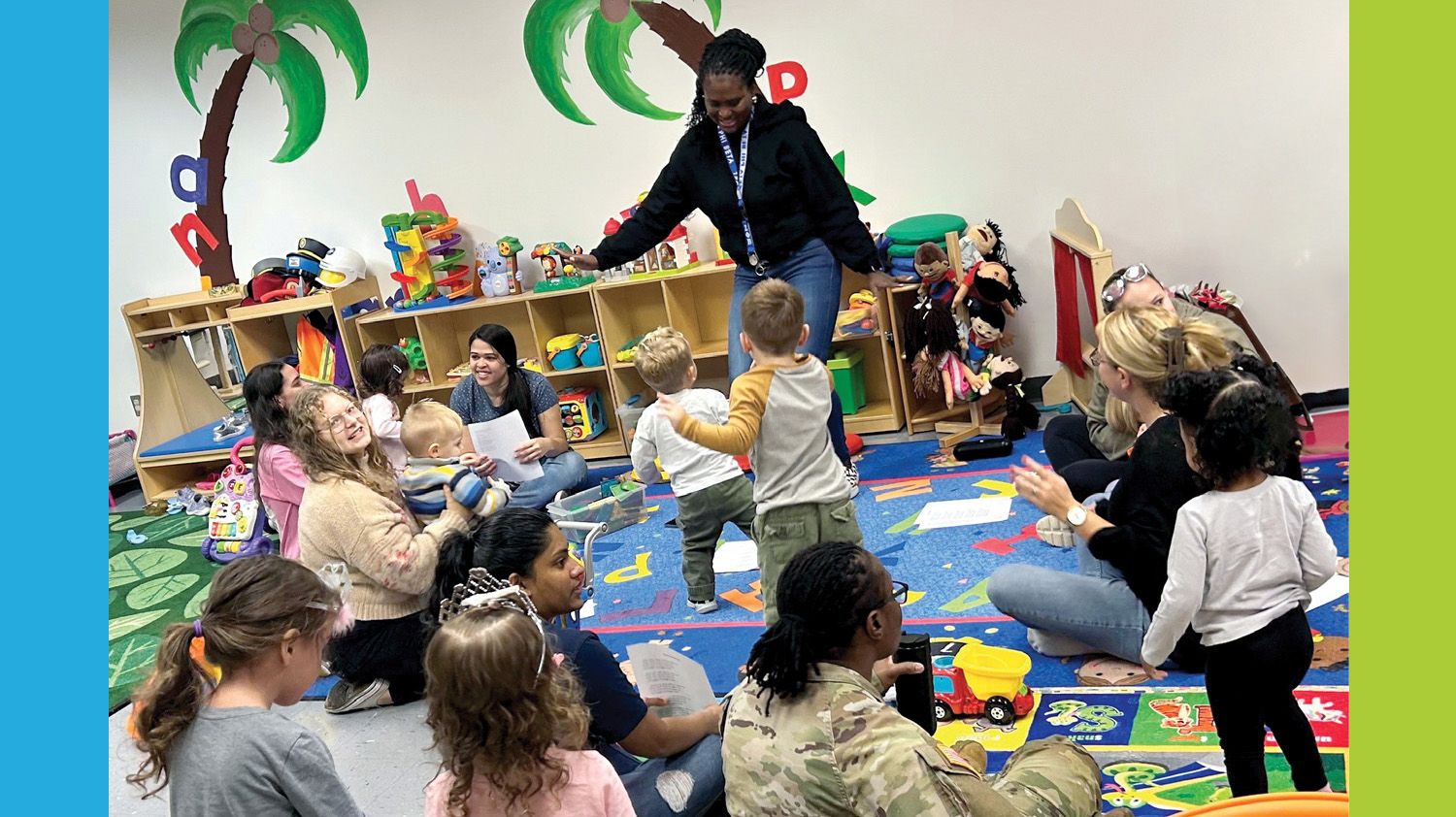- R.E.A.L. Training (Readiness Essentials for Army Leaders)
-
The training program focuses on Family Readiness mission, operations, roles and functions, and resources for support. This training is designed with the adult learner in mind and is a series of facilitated discussions, small group activities, and practical exercises. The target audience is for Command Teams, Command Family Readiness Representatives, SFRG Leaders, and other key SFRG volunteers such as Key Contacts & Informal Fund Custodians.
- SFRG Training
-
Command Team SFRG Training:
The basic objective of this training is to take a close look at the benefits of the Family Readiness Program and the Soldier & Family Readiness Group, the command team role and responsibility and the execution of the Family Readiness Plan.- Learn about Command Responsibilities to the SFRG
- Communicate the benefits of the SFRG to the SFRG Member
- Implement Command Team role and responsibility
- Execute Family Readiness Plan IAW AR 600-20 regulation
- Distinguish proper use of APF and SFRG Informal Funds
- Learn about Mission Essential Activities
- Learn about regulations that govern the SFRG program
Command Family Readiness Representative (CFRR):
Formally known as the Soldier and Family Readiness Liaison (SFRL). CFRR Appointment Requirements- assigned duty to a soldier w/ the rank of SGT or higher, may only be a Service Member, have at least 12 months of Stabilization, Shall NOT deploy, will not be assigned any additional duties, MAY speak on behalf of the Commander, IS a Leader with the SFRG structure (AR 600-20).- Identify the primary elements of the SFRG leadership team
- Define and understand the components of successful SFRG operations
- Identify how volunteers contribute to SFRG operations
- Identify methods of communicating with SFRG membership
- Understand how to execute the CFRR role within the SFRG
- Learn about the CFRR Operational Role, Administrative Role, and Support Role
- Learn about Mission Essential Activities
- Learn about regulations that govern the SFRG program
Informal Funds Custodian Training:
Formally known as the treasurer. An Informal Funds Custodian is required if funds are collected by the SFRG. The unit commander will designate in writing a primary and alternate fund custodian (AD 2019-17) The SFRG Informal Funds Custodian Mission is to maintain the custody, accounting and documentation of all monies either received, disbursed and/or deposited for the SFRG.- Understand regulatory guidance that governs SFRG operations and informal funds
- Understand the mission of the Soldier and Family Readiness Group (SFRG) program
- Define informal fund custodian rules and responsibilities
- Understand the authorized use of SFRG informal funds
SFRG Assistant Training:
The SFRG Assistant serves as the champion of the SFRG membership by supporting the Command Team’s Family Readiness Goals, maintaining open communication and relationship with unit leadership, CFRR, FRSA (if applicable) and Soldier and Family Readiness Advisors, Completing mission essential activities as outlined within the SFRG SOP and all local policies and procedures, working with command team to plan and execute approved SFRG activities, ensuring SFRG maintains communication with SFRG membership and provides information, resources and referrals as needed, attending required Family Readiness training and meetings, completing required volunteer registration and administrative tasks and recruiting and working with all SFRG volunteers.- Identify the SFRG’s role in the Family Readiness Team and the Unit Family Readiness Program
- Define and understand SFRG Mission-Essential Activities as outlined in the regulation
- Understand how to execute the SFRG Assistant role within the SFRG
- Identify methods of communicating with SFRG membership
- Recognize non-mission-essential activities, resources and professional development opportunities
- Learn about the SFRG Assistant Role and how to support the command team’s Family readiness goals, complete mission essential activities as outlined, work with command team to plan and execute SFRG activities, ensure SFRG maintains communication with SFRG membership and provide information, resources and referral.
- Learn about Mission Essential Activities
- Learn about regulations that govern the SFRG program
Key Contact Training:
Key Contacts are the grassroots means for SFRG communication and provide the human connection to SFRG members. Key contacts are trained to respond to Families inquiries and refer to agencies that provide assistance. Key contacts function in both routine and critical mode.- Understand the mission of the SFRG
- Understand the Regulatory guidance that governs SFRG operations and the Key Contact role
- Define the Key Contact Roles and Responsibilities
- Learn about mission-essential communication
- Execute the Key Contact Mission
CARE Team:
The Battalion Commander or Rear Detachment Commander may activate a care Team to assist a Family when a trauma in the unit occurs. The purpose of the Care Team is to offer short-term care and support to Families of deceased and seriously wounded Soldiers/Civilians until the Family’s own support structure is in place. The Care Team will ONLY be utilized at the request of the Family and should not be assumed to be needed in all traumatic events. CARE Teams are not mandatory, but are an additional way battalions can provide valuable support to Families.- Learn what a CARE Team is
- Learn about the Notification Process and Casualty Assistance Program
- Learn about guidance and tips for CARE Teams
- Learn how to prepare yourself for the role
- Learn what to do when arriving at the home
- Learn about the support that is available to CARE Teams
- Learn about the different Resources available to the CARE Teams
**The required functional elements of an SFRG are: Unit Commander (who serves as the SFRG Leader), Command Family Readiness Representative (CFRR), Rear Detachment Commander (RDC)-if required, SFRG Informal Funds Custodian & Alternate- required if participating in fundraising activities.
Other than the Commander, CFRR, and Fund Custodian (primary and alternate) additional volunteers may be used as the Commander deems necessary to complete the SFRG mission. Other roles may include SFRG Leaders, Key Contacts, and CARE Team volunteers.
- Virtual Family Readiness Group (vSFRG)
-
The Virtual Soldier & Family Readiness Group (vSFRG) provides all the functionality of a traditional SFRG in an online setting. The vSFRG website is the Army’s online tool to provide SFRG information to spouses. Soldiers must register spouses or other Family members under the unit website within the vSFRG to allow access.
Army Virtual SFRG: www.armyfamilywebportal.com/content/virtual-soldier-family-readiness-group-vsfrg.

A Solider & Family Readiness Group (SFRG) is a commander’s program formed in accordance with AR 600-20 and appendix J to provide activities and support that encourage self-sufficiency among its members by providing information, referral assistance, and mutual support. Family Readiness Support Assistants (FRSAs) maintain the continuity and stability of Family Readiness Teams as units undergo changes in volunteers and leadership by providing administrative and logistical support to commanders, rear detachment commanders, and volunteer SFRG leaders.


